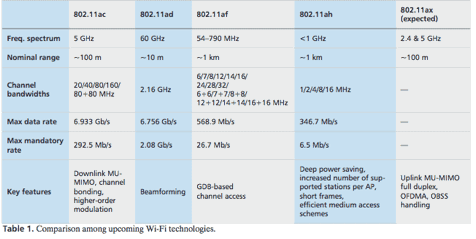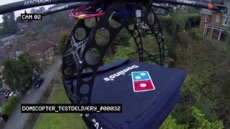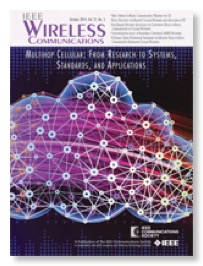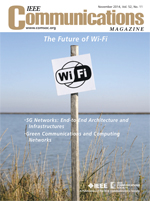New Technologies for Wi-Fi
The unlicensed crowed has not been sitting on its hands while all this new technology has been developed on the cellular side. IEEE Communications magazine in its November 2014 issue has a focus on the “The Future of Wi-Fi”.

Above is a table from one of the Wi-Fi articles that gives some future versions of Wi-Fi along with their expected technical features.
These 4 papers give an overview of the new technologies that are expected to be implemented in licensed and unlicensed wireless communications in the next few years. The wireless mic gang might want to look at these technologies and ask why they are still obsessed with 1930s-based wideband FM. But other spectrum users, including federal users regulated by NTIA, might want to view these as a data point they should be judged by.
Does Title II Regulation Inevitably Lead to Price Regulation?
Let us give two cases where services clearly subject to Title II regulation have had so much forbearance that prices rose to levels that clearly were not in the public interest. In both cases FCC, at the urging of corporate interests no doubt, continue to forebear year after year, even decade after decade.
Case I: Prison telephone rates
We see headlines on the FCC site like “FCC Continues Push to Rein in High Cost of Inmate Calling”. But dig a little deeper into the document linked to this headline and you see it starts with
“In 2013, nearly ten years after Martha Wright, a grandmother from Washington, D.C., petitioned the Federal Communications Commission (Commission or FCC) for relief from exorbitant long-distance calling rates from correctional facilities, the Commission took long overdue steps to provide relief to the millions of Americans paying unjust and unreasonable interstate inmate phone rates. These exorbitantly high rates discouraged phone calls and, at times, made it nearly impossible for inmates to maintain contact with their families, friends and communities, to society’s detriment.”
As a historical note, Ms. Wright’s grandson was actually released from prison before FCC acted on her petition! (Perhaps it is surprising that FCC did not use this as an excuse to dismiss the petition as moot.)
When FCC deregulated Operator Service Provider (OSP) prices in the 1980s because “competition was adequate” it continued to turn a blind eye to OSP pricing abuses for decades. While it should be clear that prison inmates are the original “captive audience” for carriers, it was not so clear to the leadership of the former Common Carrier Bureau and the present Wireline Competition Bureau who turned a blind eye to the problem year after year, decade after decade, under chairmen from both parties. No doubt pressure from corporate lobbyists seeking to maintain their high income streams did not hurt. Your blogger did some work for one of the carriers in this business (dealing only with cellular jamming policy within prisons) and it is the only client he ever had that he felt uncomfortable with due to the details of the business model that came up in discussions.
But FCC was perfectly able to forebear from regulation in this area even though net neutrality policy wonks think regulation is inevitable under Title II.
Case II: International telephone rates from cell phones and wireline carriers
OK, you may say that in the prison case they finally did regulate so it is inevitable. Here is an example where FCC forbearance continues despite not being in the public interest. Ever try to make an international call from your cellphone or landline? Consider this provision of § 201(b)
“All charges, practices, classifications, and regulations for and in connection with such communication service, shall be just and reasonable, and any such charge, practice, classification, or regulation that is unjust or unreasonable is declared to be unlawful”
Here are AT&T’s present rates for a call from a landline phone:

(Clicker here to AT&T’s high rates to other countries)
While these rates are less than the AT&T rates from the 1970s, about $3/minute, they are not significantly less and certainly do not reflect the economies of today’s telecom technology. Why are these prices so high? (Trust me, the other cellular and wireless carriers are all about the same.) Forbearance! Public interest be damned, be nice to lobbyists and vested interests forbearance! Works at FCC under both parties.
Fundamental Flaw of the Docket 14-165/6 4 MHz Wireless Mic Set-Aside:
Giving Free Spectrum for “Licensed Wireless Microphones” to Mostly Rich Corporations That Will Inevitably Be Very Lightly Used

However, certain private entities decided to expand this de jure use with additional de facto use without the benefit of public policy deliberations and such use would appear to have been a criminal violation of §301. Yet the wireless mic industry, their non broadcast customers, and the FCC quietly looked the other way for decades. In Docket 01-75 the FCC described the NPRM as “an extensive review of the BAS rules and propose changes to create a more efficient BAS that can readily adapt to regulatory and technological changes.” The hypocrisy of the wireless mic industry is evident in the filing by Shure, Inc. in Docket 01-75, the only filing by any party interested in non broadcast/non film production use of wireless mics. At the time Shure was routinely marketing wireless mics to noneligible users by implying that they were Part 15 devices that did not need a license. The Shure reply comments state unambiguously in a heading:
![]()
(LPAS = Low Power Auxiliary Stations = Part 74, Subpart H)
The Shure filing goes on to cryptically mention on p. 4
While subtlely acknowledging illegal uses, they never asked that they be normalized and no other wireless mic user or manufacturer spoke at all in the 3 year long proceeding!“numerous activities conducted by businesses, religious and educational institutions, governmental bodies at all levels,law enforcement agencies, musical productions, and theatres (to name but a few). The American public relies heavily upon wireless audio equipment in the course of their daily work, worship, education and entertainment activities.”
In the new twin FCC NPRMs that deal with wireless mics, Dockets 14-165/166 we have the following proposed band plan for the “duplexer gap” between the cellular uplinks and downlinks in the repurposed 600 MHz TV spectrum after the incentive auction.
Note the 4 MHz orange colored block labeled “Licensed wireless microphones”. What is this block? It is restricted to the classic Part 74 eligibles (broadcasters CATV systems, and film producers) plus, as a result of a May 2014 R&O, the “Large venue owners or operators as defined in § 74.801 and Professional sound companies as defined in § 74.801”. The 2 new categories of users both have the requirement of routinely using 50 or more wireless microphones in productions. Note that while these entities have “licenses”, they are paying no apparent fees at all for spectrum access. (Broadcasters both application fees under §1.1104 and pay annual fees under §1.1153, but there do not appear to be any fees at all for wireless mic users in the litany of Part 1, Subpart G fees unlike virtually all commercial users.)
We note that for about 20 years, the general trend has been users of spectrum for commercial purposes pay for spectrum access. So the nonbroadcast wireless mic users are being rewarded for their illegal squatting up until 2010 with guaranteed access to spectrum at no cost at all! Who are these impoverished users? Here are two recent Internet ads from newly eligible users:

Could Lion King and their corporate parents at Disney afford to pay for spectrum use?


But the worst part of the proposal is that it is a return to the “Command & Control” spectrum model of the past that rewards special interests and contributes to the overall low occupancy of US spectrum. When averaged over the entire US and over the entire year, the 4 MHz set aside for “Licensed wireless microphones” will likely be the least utilized nonpublic safety spectrum in the US and may actually be the lowest utilized spectrum even considering public safety. (Public safety spectrum tends to have low utilization due to the bursty unpredictable nature of emergencies and the need to size the spectrum for the worst case incident.)
Yes, in a small section of Manhattan it will be used for a few hours a day. In Central Park and other concert venues it will be used for a few hours a few days of the year. Near some large churches it will be used a few hours a week. But the rest of the time it will be denied to all other users, both licensed and unlicensed. At present wireless mic licensed users have priority access to “vacant” TV channels. The new proposals will make them the sole possible user of 4 MHz, deny that spectrum 24/7 to other users even if there is no wireless mic use within 100 miles, and guarantee the very low utilization of that spectrum 24/7 in 50 states plus territories. Why?
So you ask how would your blogger deal with spectrum for wireless mics? He would have a set aside for wireless mics, but it would be much smaller, it would have a spectrum efficiency standard similar to Part 90, and it would apply to only small wireless mic system users who can not afford the transactions costs of a normal licensed system. Thus eligible users would be wireless mics in office conference rooms, places of worship with modest audio systems, and hotels for DJs and conferences. Perhaps a 10 microphone maximum. For bigger users who need high reliability, they would have to pay for spectrum access either through a variant of the UK system spectrum leasing system managed by Arqiva or through a femtocell-like system provide by cellular operators. For more details on the femtocell-like alternative, see an interview with your blogger in the wireless mic blog RF Venue.
In the UK,all wireless mic users (PMSE in UK jargon) have been paying for spectrum for over a decade. Has it resulted in the “the day the music died”?
This 4 MHz proposal is the worst example of Command & Control spectrum policy since it was discredited in the Spectrum Policy Task Force report in 2002!
UPDATE
For a very different point of view, try this piece from NPR. (Oddly, it also uses Lion King as an example, but doesn’t mention the ticket price. FYI, in London where Disney has to pay for spectrum for wireless mics/PMSE, the cost of seats near the front is £70.75 - £90.00 ($111- $141) so less than in NYC with present “free spectrum”.)
Our recent FCC filing in Docket 14-166 expands on the above discussion.
As Positive Uses of Drones Appear, FCC Still Too Distracted to Look at Spectrum Issues
Drones and spectrum have been a recurring topic in this blog. But there is no visible action from FCC on any aspect of this problem although insiders have told your blogger that it has been discussed at high levels in FCC. Comm. Clyburn mentioned pending drone legislation in a March 2014 speech, but that is the most visible action that has been public.
The fundamental problem here is that FCC, in your blogger’s opinion, has a fundamental gap between its throughput capacity for making spectrum policy decisions and the workload before it. Part of this is that the structure of decision making at FCC may be inappropriate for many technical decisions that are not fundamentally political. Regardless of the cause, FCC is continuing to fall behind in its workload as it struggles with the megaissues before it: incentive auctions, net neutrality, and corporate mergers.

But while Congress has told FAA to act on drone issues by next year, FCC is part of the issue also and seems to be ignoring the issue of spectrum access by drones and whether access ins one bands, e.g. Wi-Fi and cell phone bands, might cause negative impacts. Sources in the cellular industry have confirms to be concerns about drones using cellular spectrum for smart phones at heights of 100-200m, but the industry is reluctant to raise any new issue before FCC that might distract from the spectrum auction. Another sign of the present decision making throughput shortfall.
UPDATE
Here is an article about a drone being sold by Amazon for a one day sale price of under $60 that uses “spread spectrum” in the 2.4 GHz ISM band, home of most Wi-Fi systems. While this one appears to have limited altitude capability, Wi-Fi users might want to contemplate the pfd footprint of a similar device at 100m or higher, not to mention the specter of Wi-Fi jamming from those concerned about “peeping drones”.
5G Will Probably Need an Aggregation of Technologies - Not Just More Spectrum

The new October 2014 issue of IEEE Wireless Communications magazine is a special issue on mulithop cellular - one of the technologies that will likely be part of 5G cellular. While there is no consensus yet on what exactly 5G will be, one article reports:

“it is widely agreed that in contrast to 4G networks, 5G network should achieve 1000 times the system capacity, 10 times the spectral efficiency, higher data rates (i.e., 10 Gb/s for cell center users and 5 Gb/s for cell edge users), 25 times the average cell throughput, and 5 times reduction in end-to-end (E2E) latency, and support 100 times more connected devices with 10 times longer battery life for low-power devices.”
By contrast, gsmhistory.com gives 3 different visions of 5G:
- A super-efficient “universal” mobile network that is always attentive to demand and where resources are continuously optimised to deliver a performance that is “always sufficient” – so users will perceive that they are connected to a network of infinite bandwidth. It would not just be data speed performance that is optimised but low latency needed by applications such as the Internet of Things. It is a revolution in “efficiency” delivering much better performing networks for a lower cost of investment. (Such networks are sometimes called DAN or Demand Attentive Networks). It would re-purpose existing spectrum to work in more efficient ways.
- A super-fast “mobile” network comprising the next generation of small cells densely clustered together to give a contiguous coverage over at least urban areas and delivering peak data rates of up to 1 Gb/s. It gets the world to the final frontier for true “wide area mobility”. Spectrum for this would be under 4 GHz (in order to make wide area coverage economically feasible). Since nobody is likely to reserve spectrum for 5G such a network would enter the market through advanced spectrum sharing – so in this vision 5G might be the first global implementation of Dynamic Spectrum Access. The band 3.4-3.6 GHz has been talked about for such a “spectrum sharing” market entry for 5G.
- A converged wireless-fiber network that uses, for the first time for wireless Internet access, the millimeter wave bands (20 – 60 GHz) so as to allow very wide bandwidth radio channels able to support data access speeds of up to 10 Gb/s. The connection essentially comprises “short” wireless links on the end of local fiber optic cable. It takes data over wireless to the state of the art. But this very high data speed comes at a price for consumers in terms of very much reduced coverage. It would be more a “nomadic” service (like WiFi) ie to fixed locations rather than a wide area “mobile” service

- Advanced coding and modulation techniques for 5G such as non-orthogonal wave form (NOMA).
- Spatial modulation (SM)
- Millimeter wave (mmWave)
- Visible light communication (VLC)
- Massive MIMO
- Cognitive radio networks (CRNs)
- Integration of Wi-Fi and core
- Local caching
- New heterogenous architecture - separate indoor and outdoor technologies
- Direct mobile-to-mobile communications
The introductory editorial explains the significance of the last point
“It has been more than a decade since the multihop cellular network (MCN) architecture was first proposed and analyzed in 2000. As the transmission range decreases k times, the number of simultaneous transmissions and hop count increase by k squared and k times, respectively, which leads to k times cellular capacity increase. Fundamental research projects have demonstrated the benefits of MCN interms of system capacity, service coverage, and network connectivity. Many special issues have been devoted to this stream of research. The actual concept behind the MCN architecture could be regarded as a hybrid of mobile ad hoc networks (MANETs) and cellular networks. This concept of “relaying within a cell” also pushed standard bodies to consider solutions embedded with mesh or ad hoc architectures, such as IEEE 802.11s, IEEE 802.15.5 , and IEEE 802.16j . Now, in the recent standards of the Third Generation Partnership Project (3GPP), Proximity-Based Services (ProSe) related work items also cover the MCN concept. In addition to device-to-device (D2D) direct communications, user equipment (UE)–UE relay and UE–network relay are also supported features.”
Note that in the above discussion new spectrum is included, but is not a “magic bullet” to achieve 5G goals of capacity increase. Synergy among a variety of approaches is needed for such increases. Although not explicitly mentioned, a massive increase of sites for cellular infrastructure is also needed, as has been previously discussed.
Note also that there is a dynamic interaction between unlicensed technology discussed in IEEE802 and licensed technology discussed in fora such as 3GPP. For example, LTE is a close technological cousin of WiMax. These interactions between the licensed and unlicensed communities are beneficial for all involved, although this is rarely discussed in policy circles.
So why is new spectrum the only 5G issue getting attention at FCC?





![Validate my RSS feed [Valid RSS]](valid-rss-rogers.png)

